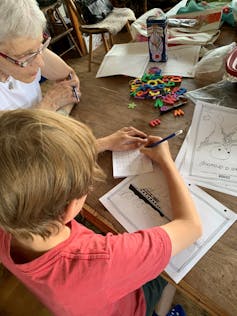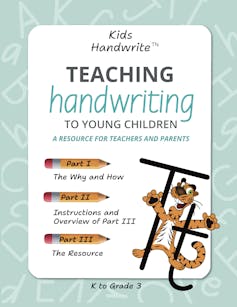Good handwriting is not an end in itself. Rather, it is a means to literacy that fundamentally transforms the human experience. Developing control over the shape of the 26 letters of the alphabet ultimately unlocks the ability to engage in the world of fact, fiction — and endless possibilities of the imagination afforded by written communication.
Legible, fluent handwriting makes this possible. Legible handwriting can be achieved by the vast majority of young learners by the end of Grade 2, given direct instruction and ample opportunities for practice. Fluency can follow in a similar fashion with continued instruction and practice.
Currently, far too many young children fail to achieve handwriting benchmarks to succeed with the academic written demands of Grade 4.
Cursive handwriting was reintroduced on the Ontario Grade 3 curriculum in June 2023, soon followed by California. Yet school instruction in cursive is bound for failure unless strong resource support is provided for kindergarten to Grade 3 teachers.
Open-access resources for cursive handwriting
(Hetty Roessingh)
I collaborated with volunteers from the Bow Valley Calligraphy Guild in Calgary, Alta., and drew on more than 10 years of tracking and publishing data on young children’s handwriting to create Teaching Handwriting to Young Children, an open-educational resource.
Our resource, downloadable in 15 user-friendly files, covers concepts and skills
leading up to and including cursive handwriting in the kindergarten to Grade 3 years.
Proficiency grows gradually
Becoming proficient in handwriting is a gradual, protracted process. It must begin early and align with developmental markers of children’s neuromotor and cognitive readiness to engage with the unfolding demands of handwriting. In turn, there are also demands of generating quality text.
Research suggests that a hybrid script, described as a clean, uncluttered manuscript-cursive hand, will most readily develop legibility and fluency. Legibility and fluency of handwriting in turn create neuronal patterns and networks. These support complex processes of organizing, planning, revising and retrieving precise and nuanced vocabulary.
We focus on instructing children in italic printing and cursive or connected script for a variety of reasons:
- economy of effort, ease of execution and demand on young learners’ musculature and visual motor memory;
- ease in transitioning from print to cursive hand by learning only a few connector strokes;
- the elegance and simplicity of the script itself.
Strong foundational skills
The three-part resource comprehensively mobilizes research to explain the “how and why” of teaching cursive handwriting.

(Shutterstock)
It introduces cursive handwriting instruction and includes specific lessons to use with children, from “pre-printing” activities (like colouring, tracing and connecting dots) to lined sheets demonstrating script and letter spacing. Resources are accessible with rich use of photos, illustrations of children’s work, easy layout and design.
The resource combines theory and practice to help teachers or parents instruct children in developmentally progressive ways, beginning with setting in place strong foundational skills.
At school, the focus is:
In kindergarten:
Children must be able to reconstruct internal mental models of letters seen on a page, and then with fine motor control, reproduce letters onto a page.

(Hetty Roessingh), Author provided (no reuse)
When a child can print their name at the size of about three-quarters of an inch, this is a key indicator the child has developed basic print concepts. This means they understand print is a representational system of mapping sounds to letters. They are in early stages of recognizing this through letters in their name, and so they learn to generalize to the entire alphabet. Shape recognition is really important here too, usually in early kindergarten.
By the end of kindergarten, young learners should be able to print most of the lower and upper case letters. This involves enormous amounts of tactile experiences with letter shapes, games and activities for developing a good pincer grip, using the tools of literacy (crayons, pencils) in developing control over fine motor skills such as drawing, colouring and “staying between the lines” tasks.
A play-based approach that is engaging and fun for young children is important in motivating and creating a sense of confidence and agency in these early, emergent moments of written literacy learning. Training the muscle memory in these skills so they eventually come automatically are the keys to the next step in literacy development.
To help children learn how to read in the pandemic, encourage writing messages as part of play
Grade 1
Direct instruction in handwriting begins in Grade 1 with short, consistent lessons of 20 minutes, with another 40 minutes of practice opportunities during the day. Making labels, greeting cards, thank you notes, crafts and lists reinforce these foundational skills.
Handwriting should be legible at the end of Grade 1.
Grade 2

(Hetty Roessingh), Author provided (no reuse)
Grade 2 represents a transition point where the joins or ligatures are introduced. Again, this involves movement and patterning exercises for developing the muscle memory for connecting letters beginning with the diagonal move such as ai, an.
Making connections and minimizing the number of “lift offs” (where pencil must lift from the page) facilitates developing speed, thus opening precious working memory space for other demands of generating text such as retrieving and mobilizing precise and nuanced vocabulary choices. Young learners continue to work on letter shape and size.
Grade 3
Grade 3 consolidates these foundational skills by making increased numbers of connections and control over shape, size, space and slant of handwriting — with indicators of speed or fluency of hand.
It becomes clear that developing fluent handwriting imposes many competing demands on young learners. Early, direct, programmatic, developmentally progressive, sustained instruction with ample practice opportunities throughout the school day can go a long way toward realizing better handwriting outcomes among our young learners and in turn, better academic outcomes.
Good instruction and resource support are key to achieving this success.




